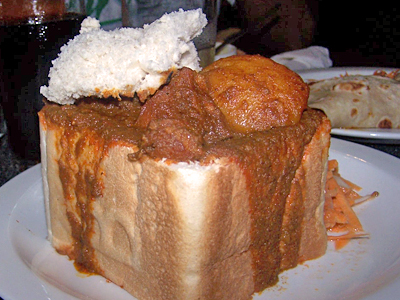In keeping with an expression of interest regarding events showcasing / introducing fellow cachers to world cuisine, I hereby invite you to the next occasion, themed as an Indian / Bunny Chow evening in honour of our late father, Peter (Aka Technonut).
Technonut passed a year prior to this event, on 25 July 2017. It is a well known fact that our dad loved bunny chows, and was keen on starting up a monthly bunny chow event similar to the ones held in Durban.
Where: Lugz Indian Cuisine - Canterbury Crossing - 117 Bram Fisher Drive, Ferndale
Date: Wednesday 25 July 2018
Time: 18:30 until 21:00 (or until the last Geocacher leaves!)
You do not need to purchase anything to attend the event, and you are most welcome to pop in for 5 minutes.
Bunny chow, often referred to as a bunny,is a South African fast food dish consisting of a hollowed out loaf of bread filled with curry. It originated in the Durban Indian community.A small version of the bunny chow that uses only a quarter loaf of bread is sometimes called by black South Africans a kota ("quarter"), a name that it shares with spatlo, a South African dish that evolved from the bunny chow.

The bunny chow was created in Durban, home to a large community of people of Indian origin. The precise origins of the food are disputed, although its creation has been dated to the 1940s. It was also sold in Gwelo, Rhodesia (now Gweru) during World War II and is still sold in the nearby town of Kadoma, formerly known as Gatooma.
Stories of the origin of bunny chow date as far back as the migrant Indian workers arrival in South Africa. One account suggests that migrant workers from India who were brought to South Africa to work the sugar cane plantations of Kwazulu-Natal (Port Natal) required a way of carrying their lunches to the field; a hollowed out loaf of bread was a convenient way to transport their vegetarian curries. Meat based fillings came later. The use of a loaf of bread can also be ascribed to the lack of the traditional roti bread, in the absence of which a loaf of bread would be acceptable as an accompaniment to curry.
One story has it that a restaurant run by people known as Banias (an Indian caste) first created the scooped-out bread and curry dish at a restaurant-cum-café called Kapitan's on the corner of Victoria and Albert streets in Durban. The food was a means to serve take-aways to excluded people. During the apartheid regime, Indians were not allowed in certain shops and cafes and so the shop owners found a way of serving the people through back windows, etc. This was an easy and effective way to serve the workers. One story opines that the origin of this hand-held dish was due to Indian golf caddies not being allowed to carry cutlery during apartheid.
The traditional Indian meal was roti and beans, but rotis tended to fall apart as a take-away item, so they cut out the centre portion of the bread and filled it with curry and capped the filling with the portion that was cut out. The vegetarian version is known as a beans bunny. A further, albeit unlikely, etymology is derived from bun and achar (Indian pickles), though the latter are not included in the dish.